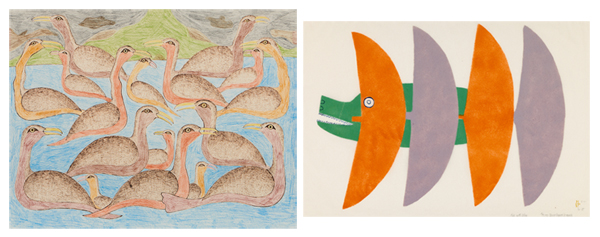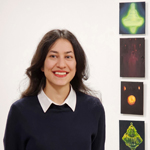Visual Echoes
By: ArtBank / 14 May 2024 From left to right: Velma Foster, Jacques Palumbo, Michael Snow, Judy Martin, John Massey, Denis Demers, Dyan Marie, Robert Hedrick. Photo: Brandon Clarida Image Service
From left to right: Velma Foster, Jacques Palumbo, Michael Snow, Judy Martin, John Massey, Denis Demers, Dyan Marie, Robert Hedrick. Photo: Brandon Clarida Image Service
For Doors Open Ottawa 2024, the Art Bank is pleased to present Visual Echoes, a thematic display exploring the beauty and complexity of visual patterns as one of the most ubiquitous art-making practices that transcends cultural boundaries and time periods.
From the mere repetition of motifs to the intricate manipulation of images, this selection of over 30 artworks brings to light hidden narratives and harmonies that shape our understanding of art and the world around us.
At the core of this exhibition lies the idea that repetition establishes balance and order, yet can also lead to disorienting chaos when pushed to extremes. As formal and spatial relationships undergo development, amplification and, at times, delightful disruption, they reveal the transformative power of rhythm and its ability to shape and reshape our perceptions.
Featured work by John Massey
Navigating the faculties of perception and orientation in space is central to John Massey’s artistic pursuits. His collage, compounded of fragmented body parts, spiraling inwards or outwards, seeks to illustrate the relationship between the body and its incarnation in space and time, capable of expansion or contraction ad infinitum.
The print assembles cut-out photographic images, forming a complex and visual structure that provokes us into considering how we perceive the world around us.
 John Massey, Black Eye (1988–89), lithograph and silkscreen
John Massey, Black Eye (1988–89), lithograph and silkscreen
Featured work by Frank Shebageget
Featuring the evolution of Canadian five-dollar banknotes from vintage to modern, Frank Shebageget’s Free Ride (2022) symbolizes the enduring significance of Treaty 3. In 1873, the agreement between Chief Mikiseesis on behalf of the Ojibwe First Nations and Queen Victoria persuaded the tribe to surrender their ancestral lands in return for a meager yearly compensation of $5.00 per head.
The artwork prompts contemplation on the injustices inherent in such agreements and their repercussions on contemporary Indigenous (and non-Indigenous) identity.
 Frank Shebageget, Free Ride (2022), vintage and recent Canadian five-dollar banknotes, engraved maple frame
Frank Shebageget, Free Ride (2022), vintage and recent Canadian five-dollar banknotes, engraved maple frame
Featured work by Joseph Calleja
The exhibition also features three-dimensional artworks, including Maltese-Canadian artist Joseph Calleja’s kinetic sculpture. Built in polished chromed steel and moved by concealed motors, the sculpture generates undulating forms together with reflected bursts of light. This mesmerizing sculpture aspires to an animated form of abstraction where cyclic patterns evoke fluidity and intrigue through the reductive elegance inherent in its concept.
 Joseph Calleja, Untitled (1972), stainless steel with wood base
Joseph Calleja, Untitled (1972), stainless steel with wood base
Featured works by Jessie Oonark and Kenojuak Ashevak
From the Art Bank’s extensive Indigenous art collection, Inuit artists Jessie Oonark and Kenojuak Ashevak are represented with two notable pieces showcasing their unique artistic perspectives. Weaving a story with bright colours and traditional symbolism, Oonark’s Fish with Ulus (1981) unites these elements in a simple yet compelling composition.
Her capacity to distill the subject into fundamental geometrical shapes, particularly the triangle with a rounded side, elevates the representation into a glimpse of daily Inuit routines.
On the other hand, Ashevak’s vision of nature as a unified, animated and perpetually transforming whole brings to life the coordination among birds and chicks, vividly portraying their essence within a close spatial relationship. The open beaks of the birds suggest a lively chorus of life, echoing the simplicity and vibrancy of the natural world.
 Left: Kenojuak Ashevak, Untitled (1981), felt pen and coloured pencil on paper
Left: Kenojuak Ashevak, Untitled (1981), felt pen and coloured pencil on paper
Right: Jessie Oonark, Fish with Ulus (1981), stencil
Do you want more opportunities to engage with this exhibition?
In this exploration of Visual Echoes, the Art Bank invites viewers to experience the interplays of evolving patterns, where the pulse of repetition not only creates a rhythmic composition but also reveals narratives and reflections on our collective history and identity.
If you can’t make it to Doors Open Ottawa on June 1, or if you would like to amplify your visit, the Art Bank has introduced a new Web application that provides even more access to the collection. Explore the app!

About the Curator: Fara Abn
Fara is an Ottawa-based curator and researcher. After completing her studies in Visual Cultures and Curatorial Studies in Italy, she is pursuing a PhD in Cultural Mediations at Carleton University. Her current research explores display strategies and the impact of political and private interests on national representations at the Venice Biennale. Fara was invited to guest curate the Art Bank’s 2024 Doors Open Ottawa thematic display as a practicum placement towards her graduate diploma in curatorial studies.